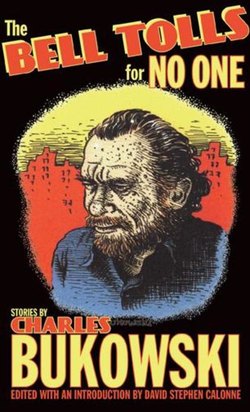Читать книгу The Bell Tolls for No One - Charles Bukowski - Страница 6
На сайте Литреса книга снята с продажи.
ОглавлениеINTRODUCTION NOTES
1. “The Reason Behind Reason,” Matrix, vol. 9, no. 2, Summer 1946 in Absence of the Hero, ed. David Stephen Calonne (San Francisco: City Lights, 2010).
2. Charles Bukowski letter to Whit Burnett, Box 19, Folder 13; Princeton University Library.
3. François Rabelais, Gargantua and Pantagruel, p. 677; “Ultimate Religion,” in The Essential Santayana, ed. Martin A. Coleman (Bloomington: University of Indiana Press, 2009), p. 344.
4. Absence of the Hero, pp. 255–270.
5. See David Stephen Calonne, Charles Bukowski (London: Reaktion Books, 2012), pp. 31–32; also see footnote 8, p. 185).
6. See Erin A. Smith, “Pulp Sensations” in David Glover and Scott McCracken, The Cambridge Companion to Popular Fiction (Cambridge University Press, 2012); on Bukowski and Pulp, see Calonne, Charles Bukowski, pp. 171–173; Paula Rabinowitz, American Pulp: How Paperbacks Brought Modernism to Main Street (Princeton University Press, 2014), pp. 296–297.
7. Charles Bukowski, “the lady in red,” in Dangling in the Tournefortia (Santa Barbara, CA: Black Sparrow Press, 1981), p. 13.
8. Jack Black, You Can’t Win, Introduction by William S. Burroughs (Edinburgh: AK Press/Nabat, 2000).
9. Wallace Fowlie, “Shadow of Doom,” in The Happy Rock: A Book About Henry Miller (Berkeley, CA: Bern Porter, 1945), p. 102.
10. Friedrich Nietzsche, On the Genealogy of Morals; Ecce Homo, trans. Walter Kaufmann (New York: Vintage Books, 1967), p. 150.
11. Kauri 15, July-August 1966, p. 4; on Healey, also see “Eyes Like the Sky” in Bukowski, Tales of Ordinary Madness (San Francisco: City Lights, 1983), pp. 175–180.
12. Hillary Chute, “Graphic Narrative,” in Joe Bray, Alison Gibbons, and Brian McHale, eds., The Routledge Companion to Experimental Literature (London and New York: Routledge, 2012), p. 410. Also see Patrick Rosenkranz, Rebel Visions: The Underground Comix Revolution, 1963–1975 (Seattle: Fantagraphic Books, 2002).
13. For reproductions of Wilson’s illustrations of Bukowski stories, see Patrick Rosenkranz, Demons and Angels: The Mythology of S. Clay Wilson, Volume 2 (Seattle: Fantagraphic Books, 2015).
14. Crumb remarked about Bukowski: “I like his ironic humor and his alienated attitude about the world in general. He expresses that in very succinct and eloquent terms.” See D.K. Holm, ed., R. Crumb, Conversations (Jackson: University of Mississippi Press, 2004), p. 208.
15. On The Way the Dead Love, see Abel Debritto, Charles Bukowski, King of the Underground: From Obscurity to Literary Icon (New York: Palgrave MacMillan, 2013), pp. 127, 135–6.
16. The poem may be found in Pacific Northwestern Spiritual Poetry, ed. Charles Potts (Walla Walla: Tsunami Inc., 1998), pp. 48–51.
17. Los Angeles Free Press, Feb 13–19, 1976, p. 20.
18. See Absence of the Hero, pp. 99–111.
19. David Stephen Calonne, “Bukowski and the Romantic Conception of Genius,” Jahrbuch der Charles-Bukowski-Gesellschaft 2011/12/13, pp. 217–218.
20. The Charles Bukowski Tapes, DVD, directed by Barbet Schroeder (Detroit, MI: Barrel Entertainment, 2006).
